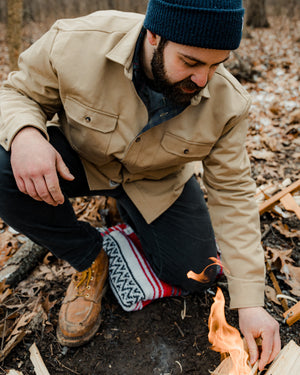Mastering the Art of Smoking Meat

Everybody loves a MuskOx Man, especially one that can cook, but a man that can smoke meat? Now that’s next level! Smoking meat is a time-honored culinary tradition that transforms ordinary cuts of meat into tender, flavorful masterpieces. Whether you're a seasoned pit master or a novice backyard chef, mastering the art of smoking meat can elevate your barbecue game to new heights. In this comprehensive guide, we'll explore everything you need to know about smoking meat, from choosing the perfect wood, becoming a marinating master, and embracing essential techniques, making you the ultimate MuskOx Man.
Preparation
The art of meat smoking heavily lies in the preparation period. As a wise man once said; “if you fail to prepare… prepare to fail”. Since smoking meat traditionally involves using wood or wood chips to generate smoke, you need to make sure you start out by choosing the right wood.
 MuskOx Grand Flannel in Navy
MuskOx Grand Flannel in Navy
Selecting the Perfect Wood
The type of wood you use plays a crucial role in the flavor profile of your smoked meat. Some popular options include:
Hickory: Hickory wood imparts a strong, robust flavor that pairs well with pork, beef, and poultry. It's one of the most widely used woods for smoking meat and adds a rich, smoky aroma to the finished product.
Mesquite: Mesquite wood is known for its intense, earthy flavor and is commonly used in Texas-style barbecue. It's best suited for bold-flavored meats like beef brisket and ribs.
Apple: Apple wood provides a mild, fruity flavor that compliments your meat. It adds a subtle sweetness and is popular for smoking ribs, chicken, and salmon.
Cherry: Cherry wood offers a slightly sweet and fruity flavor with a hint of tartness. It's versatile and pairs well with a variety of meats, including pork, poultry, and game.
Once you've chosen the type of wood you want to use for smoking your meat, the next steps involve preparing your smoker and the meat itself. Here’s what you should do:
Ensure your smoker is clean and free from any leftover ash or debris from previous uses. Depending on the type of smoker you have (charcoal, electric, gas, or wood), follow these steps:
Charcoal Smoker: Arrange charcoal briquettes or lump charcoal in the firebox or charcoal chamber. Create a small well in the center to facilitate lighting.
Electric Smoker: Plug in the smoker and set the temperature according to your recipe or smoking guidelines. Some electric smokers require you to add wood chips or pellets for smoke production. Soak wood chips in water for at least 30 minutes (if using charcoal or electric smokers). Drain before adding to the smoker.
Gas Smoker: Connect the propane tank or natural gas line to the smoker. Adjust the burner settings to achieve the desired smoking temperature. You may also need to add wood chips or chunks for smoke flavor.
Wood Smoker: Ensure you have enough dry wood chunks or chips ready. Place a few chunks directly onto the hot coals or in the smoker box (if your smoker has one).
The next step in preparation is to preheat your smoker to the desired temperature range for smoking (typically between 225-275°F / 107-135°C). Use the smoker’s built-in thermometer or an external thermometer to monitor the temperature. Allow the smoker to stabilize at the desired temperature before adding the meat. This can take some time, especially with charcoal smokers where you may need to adjust vents to control airflow.
Of course your smoker is not the only thing to prepare. You’ve got to prepare your meat as well. Trim excess fat and silver skin from the meat if necessary. Season the meat with your preferred dry rub or marinade. Apply the seasoning generously and ensure it coats all sides of the meat.

Let the seasoned meat sit at room temperature for about 30 minutes to allow the flavors to penetrate. Alternatively, you can refrigerate the meat overnight for more intense flavor infusion.
Begin Smoking
Since you’ve prepared so well, it’s time to begin smoking! Add your soaked wood chips or dry wood chunks to generate smoke. Place them directly onto the hot coals or in the designated smoker box according to your smoker’s design.
Arrange the seasoned meat on the smoker racks, leaving space between pieces for good smoke circulation. Close the smoker lid to trap the smoke and maintain consistent cooking temperatures.
From here, it’s all about time and patience. Monitor and maintain the temperature. Adjust vents or burner settings as needed to maintain a steady smoking temperature. Add more wood chips or chunks as necessary to sustain smoke production. This helps impart the desired smoky flavor to your meat.

Avoid over-smoking your meat. Excessive smoke can impart a bitter flavor. Use a combination of wood chunks, chips, or pellets to achieve a clean, thin blue smoke.
Remember, smoking is a slow-cooking method that can take several hours, depending on the size and type of meat. Plan accordingly and avoid opening the smoker unnecessarily to maintain consistent cooking temperatures and smoke levels.
By following these steps, you’ll be well on your way to smoking meat with your chosen wood, ensuring rich, flavorful results that enhance the natural taste of the meat with a delicious smoky essence. Adjustments may be needed based on your specific smoker and personal preferences for flavor intensity.
Finish & Indulge
Verify that the internal temperature of the meat has reached the recommended safe temperature for the specific type of meat you smoked. Here are some general guidelines:
- Beef (brisket, ribs): 195-205°F (90-96°C)
- Pork (shoulder, ribs): 195-205°F (90-96°C)
- Chicken (whole): 165°F (74°C)
- Fish (varies by type): Check specific recommendations for the type of fish.
Ensure the meat is tender and easily pulls apart (for pork shoulder or brisket, for example) or firm and opaque (for chicken or fish).

Allow the smoked meat to rest for at least 10-20 minutes before slicing or serving. This resting period allows the juices to redistribute throughout the meat, ensuring it remains moist and flavorful. Optionally, you can loosely tent the meat with aluminum foil during the resting period to help retain heat and moisture.
Smoking meat is an art form that rewards patience, skill, and attention to detail. By selecting the perfect wood, mastering essential techniques, and prioritizing time for flavor, you can create mouthwatering smoked masterpieces that will impress family and friends alike. So fire up your smoker, embrace the aroma of wood smoke, and embark on a culinary journey that celebrates the timeless tradition of smoking meat.

























